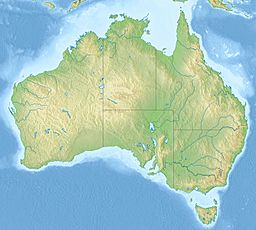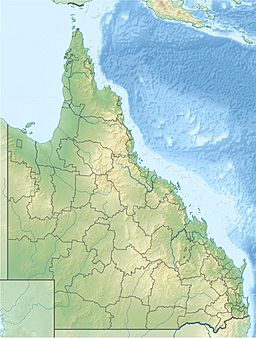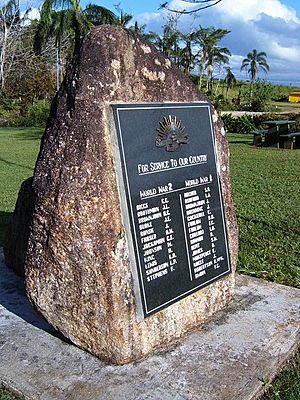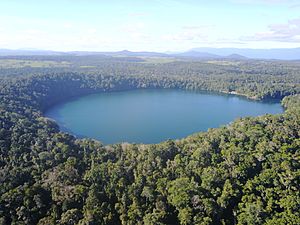Lake Eacham (Queensland) facts for kids
Quick facts for kids Lake Eacham(Yidyam or Wiinggina) |
|
|---|---|

View of Lake and Lake's edge from a Queensland National Parks viewing platform.
|
|
| Location | Atherton Tableland, Queensland, Australia |
| Coordinates | 17°17′06″S 145°37′30″E / 17.285°S 145.625°E |
| Type | Crater lake |
| Basin countries | Australia |
| Surface area | 429,582.77 m2 (4,623,990.5 sq ft) |
| Average depth | 65.5 m (215 ft) |
| Max. depth | 66 m (217 ft) |
| Water volume | 16,812,000 kL (593,700,000 cu ft) |
Lake Eacham (also known as Yidyam or Wiinggina) is a beautiful lake in Queensland, Australia. It was formed by a volcano and is located on the Atherton Tableland. This area is part of the Wet Tropics of Queensland, which is a special place protected by the World Heritage program. The lake is a popular spot for families and tourists to visit.
Contents
How Lake Eacham Was Formed
A Fiery Beginning: Geology
Lake Eacham, or Yidyam, was created over 9,130 years ago. Deep inside the Earth, hot, melted rock called magma moved upwards. This magma heated the underground water. The boiling water turned into steam, which was trapped deep below the surface.
Eventually, huge explosions happened, releasing the steam. Giant cracks appeared in the ground. Trees that once covered the mountainside were knocked down and burned. After these eruptions, rainwater filled the deep hole, which is called a crater. Over time, new trees grew back, forming the peaceful lake we see today.
- No rivers or streams flow into or out of Lake Eacham.
- Water is only lost when it soaks into the ground or evaporates into the air.
- The lake's water level changes with rainfall, sometimes by as much as 4 metres!
- A nearby lake, Lake Barrine, was formed in a similar way, even longer ago.
An Ancient Story: Mythology
The local Aboriginal people, the Ngadjon-jii, call the lake Wiinggina. They have a special story about how the lake was formed. This story has been passed down through many generations.
"Two young fellas were trying to spear that wallaby. But they missed and hit a flame tree. That’s a sacred tree. The young fellas not supposed to be out hunting. They weren’t initiated. Their elders told them to stay put, not go out hunting. But they didn’t listen. When they pulled their spear out, part of a grub came out with the spear, which was a witchetty grub. They started cutting down that tree to get more grubs. When they cut down that tree, the ground began to shake. Those two fellas had made Yamini (rainbow serpent) angry. Then the sky turned orange, then all these people back at the camp, the earth went from underneath them, sucked them in, whoosh, they all got drowned. Where they were camped became Bana Wiingina (Lake Eacham)." (Warren Cannendo, Ngadjon-Jii)
This story is part of the Ngadjon-jii's oral history. Many people believe it is an ancient record of the volcanic events that happened more than 10,000 years ago.
Lake Eacham's History
In 1886, Lake Eacham (Yidyam) was first planned to be divided into farming areas. However, by 1888, people realized how beautiful the lake was. It was then officially made a "scenic reserve."
For almost 50 years, from 1888 to 1936, the lake was used for fun activities. People enjoyed boating, and there was even a guest house nearby.
In 1934, the Queensland Government decided to protect the lake and its surrounding area. It became the Lake Eacham National Park. Later, in 1988, UNESCO declared the Wet Tropics of Queensland a World Heritage Site. This meant the area was very important and needed special protection. Lake Eacham was one of the protected areas.
In 1994, Lake Eacham National Park joined with Lake Barrine National Park. Together, they formed the Crater Lakes National Park.
A Special Ecosystem and a Fish's Journey
Lake Eacham (Yidyam) is a "closed ecosystem." This means no other rivers or streams flow into it. It's a bit of a mystery how fish first got into the lake!
The Lake Eacham Rainbowfish
A small fish called the Lake Eacham rainbowfish (Melanotaenia eachamensis) somehow found its way into this volcanic lake. Sadly, other larger fish were later brought into the lake by humans. These larger fish ate the rainbowfish until they disappeared from the lake.
Luckily, some people who kept fish as a hobby had collected the rainbowfish from the park (before it was illegal). They were very good at breeding them. These private collections became the source to bring the fish back. However, when the rainbowfish were put back into the lake, the larger fish were still there. They ate the new rainbowfish too.
Scientists later found the Lake Eacham rainbowfish living in other rivers nearby. These rivers include the Tully, Herbert, and Johnstone Rivers, and Dirran Creek.
Besides the rainbowfish, Lake Eacham has two other native fish species. They are the gudgeon Mogurnda adspersa and the hardyhead Craterocephalus stercusmuscarum. Any other fish in the lake were brought there by people.
Protecting Lake Eacham
Lake Eacham (Yidyam) is the main part of the Crater Lakes National Park. This park is almost 5 square kilometers in size. It is home to a thick rainforest and many small animals. Because of this, Lake Eacham is a protected area under Queensland law. The Queensland National Parks and Wildlife Service looks after the lake and its natural and cultural treasures.
The lake is about 38 metres deep on average, and its deepest point is 65.5 metres. Locals love Lake Eacham for many activities:
- Swimming
- Canoeing
- Bushwalking (walking around the lake)
- Bird watching
To keep the lake clean and quiet, no motor boats are allowed. There is a pontoon that is great for diving into the deep water. A large grassy area is perfect for relaxing. You can also walk all the way around the lake on a path, which takes about 45 minutes. If you look closely near the pontoon, you might even spot some turtles!






